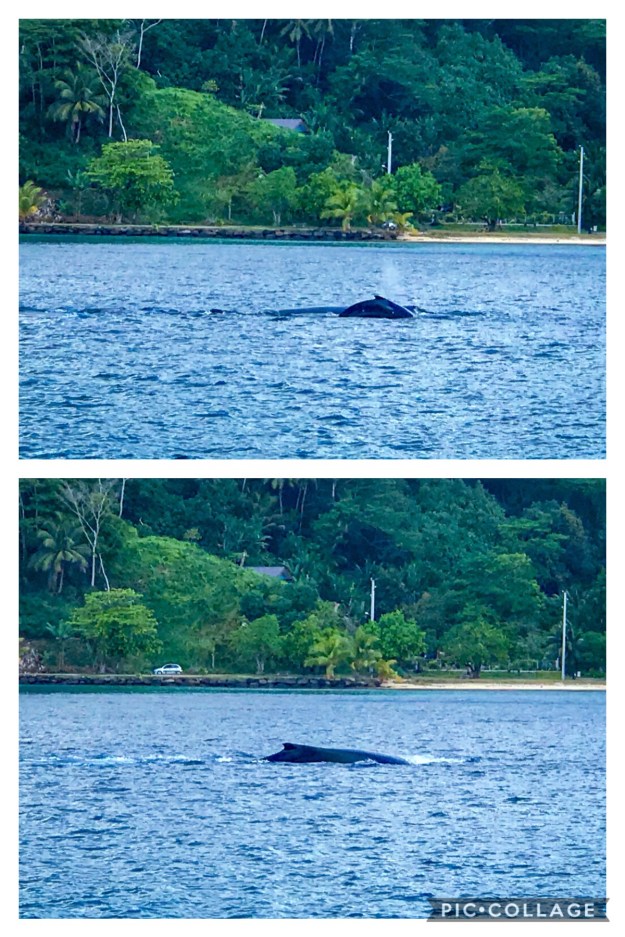Frank, the owner of Expo Coquillages (Shell Expo) or the Shell museum. He has spent 38 years collecting precious sea shells from the beach. He has built an amazingly, organized, educational, shell museum next to his house for Huahine visitors.
Frank has spent the last 38 years collecting and expanding on his private shell collection. 80-90% of the shells in his museum come from the beaches of Huahine and Rangiroa. He does not collect them from the sea as he does not want to kill the inhabitants for their shells. His museum is small, but extremely well organized. Each group of shells is in a numbered box with an index that gives their name. In many instances. He has photos of the shell with its inhabitant.
Shell Museum Tour
Frank starts off by talking about conch shells which are both beautiful and deadly. A “real” conch shell has an opening from the top to the bottom of the shell. That’s how you can differentiate a conch from another similar shell. 99% of all conch shells open to the right. Meaning if you hold a conch with the pointy part down, the opening will be to the right (top photo). Only one type of conch shell opens to the left and they are rare (bottom photo). One in a million will open in the opposite direction for both of these types of shells.

Conch shells opening to the right
Deadly Conchs
Many of these conch shells are poisonous and or deadly when they are alive. They cause 2-3 deaths per year (similar to a shark). But honestly who wants to admit they were killed by a small sea shell compared to a shark? Which is why you don’t hear much about these types of deaths.
The interesting thing is that these conch shells are afraid and will retreat when threatened. They don’t try to kill or injure humans. It is the curiosity and greed of humans that get’s them stung. Humans see the shells in the sea, pick them up, put them in their pocket and whamo – they get stung. The shells cause paralysis within 2 hours and then death. They are 32x more deadly than the cobra and there is no vaccine.
The Conch Anatomy
The conch has a snout that protrudes from the shell that does the “investigating”. When he is in danger, he jets out his stinger under the snout. It is so fast that you can’t see it with the naked eye. They can sting multiple times, like a bee. When trying to capture prey, the shell will extend its snout, then sting a fish and open its mouth to bring it to him. Sometimes it will open its mouth so wide that it collects multiple fish. When that happens, it stings the fish while inside his mouth (see lower right image).

Deadly Conch
These look like conch shells, but they are not. The opening does not extend from the top to the bottom.

Shells that look like conch shells, but are not.
The conch shell grows with its inhabitant. It is not like a hermit crab where they change shells. These little guys are nocturnal and hide during the day. By the time they reach the beach they are dead and can be collected and admired.
Shells, Shells, and More Shells
Frank has a gorgeous collection of over 500 different types of shells. Unfortunately, most of his presentation was in French so I had to rely on Floris to translate bits and pieces for me. I am sure I missed a lot of the information, but I was enthralled with the beauty of the shells none the less.

And more beautiful shells

I loved seeing many of my favorite shells at this shell museum. He had several varieties of sand dollars (I have 4 of the 5 shown in the middle picture. I’d love to get the one in the lower left corner but have never seen one like this before! I have several of the cone shells including one polished as pretty as the all pearl ones (top right photo). We also have several sea urchins (lower left) and one of the super dainty shells on the lower right.

One of my favorite shells is actually part of a defense mechanism for a large shell! I had collected many of the shells on the bottom photo with a cool swirl. I found out from the shell museum tour that this is used to close the critter inside a large shell (see top photo).

These are all my favorite shells from the shell museum. Check out the top left corner – isn’t it beautiful with its pearl stripes?

This display had the evolution of the queen conch shell (furthest away on right). This shell starts small (lower left corner) and evolves over time into a queen conch with large fingers. I am a proud owner of one of these beauties as well.

Evolution of the queen conch
In another display, Frank shows long, pointy shells that he opened up so you can see the complexity of the framework of the shell.

This cool photo shows what the shell and inhabitant look like while alive (top) then you can see the dead shell left behind (red shells toward bottom).

One of his beautiful displays

Pearls
Frank also sold pearl jewelry, carved shells, and more. He personally creates and fabricates all of the jewelry. Some of his products are made by other locals of Huahine as well.
This was an interesting summary of the quality of pearls, their color, shape, and luster. He also has the number of pearls exported. Japan and Hong Kong take 87% of the pearls from French Polynesia.

What an interesting day at the shell museum.
Events from this blog occurred on 15 October 2020. Our blog posts run 6-8 weeks behind our adventures.



























